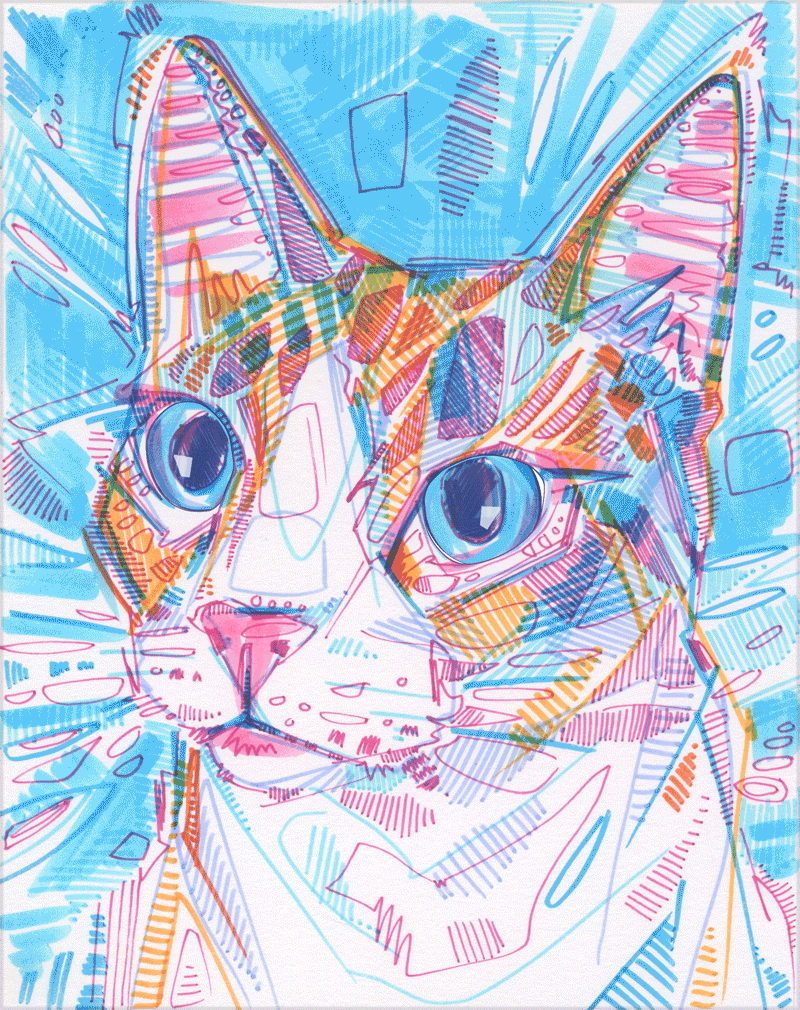Blog / 2021 / Web Free-point-oh: NFTs, DAOs, the Value of Art, and the Cutest Kitty on the Internitty
December 16, 2021
The interest in NFTs, DAOs, and crypto more generally stems from savvy marketing, and, as artists know all too well, the stories we tell can make even the most intensely mediocre stuff look amazing. My favorite breakdown of the crypto version of Web3 comes from sadgrl.online, and, if you’re interested in the DAOs I mention, here’s more about ConstitutionDAO and FWB.
I know some artists are getting into the NFT world without thinking too hard about the environmental impact. When I pushed a friend on this recently, their response was to point to all the nasty pollutants that are part of traditional art and sales—everything from the heavy metals in pigments to the carbon footprint of shipping art. This argument feels a bit insincere, but, if I take it at face value, I can only say that at least with traditional art the pollution stems from the work itself, not from writing up a special certificate of authenticity for the art.
Like David Revoy, whose unfortunate NFT run-in I wrote about in September, I want to make it clear that if you ever see an NFT of my art you can be sure I have nothing to do with it. The whole concept of trying to lock down digital images is antithetical to my free culture world view.

Whatever Cat GIF
2021
digital animation
(Buy a print of this image sans animation here.)
VIDEO TRANSCRIPT
An NFT is a little like a certificate of authenticity for a digital thing, and that’s actually kind of revolutionary considering that, on the web, everything is infinitely copiable.
For example, me having a digital image like this animated art GIF of an unimpressed kitty doesn’t stop you from having the same digital animation. We can both have the GIF, and we can each pass it along to everyone we know without damaging the GIF itself. Digital’s ability to copy infinitely is pretty magical in a world of scarcity, a world where there’s only so much of most resources—only so much oil, only so much time, etcetera. The internet’s abundance is freakily fantastic.
And NFTs are trying to impose scarcity on this inherent abundance.
Let’s say I decide to sell an NFT of this cat GIF. First I need to spend anywhere from 80 to 300 American dollars to “mint” the NFT. Minting is the process of asking people (or, more realistically at this point, companies) who own fancy computers to crunch huge numbers and produce an NFT, AKA a nonfungible token, AKA a one-of-a-kind certificate.
When someone buys the NFT, they’re not buying the cat GIF or even the right to be the only one to share the GIF. They’re literally buying the NFT. They’re buying a one-of-kind big-crunched-numbers certificate, and the artwork—the silly cat GIF—is still just as available to you, me, and everyone you know. In other words, anytime you read about someone spending hundreds of thousands of dollars to purchase an NFT, please imagine them laying down all of that cash to get a certificate.
Now part of me is like: that’s obviously dumb, but, if someone is willing to spend all of that money for a certificate, well then at least the good thing is that an artist is getting paid...?
Because the fact is that value is as people do. If someone is spending this money for these certificates then, logically, there must be some value there. And you could easily argue that art is a “value is as people do” kind of a thing as well. I mean there’s no intrinsic value to this adorable cat animation. We make that value. So, you might ask, what makes buying an NFT so different from just paying an artist for a GIF?
The simple answer is the Amazon.
And I’m talking about the rainforest here, not the terrifying tech giant that murders human dignity on a daily basis. Minting, selling, and re-selling a single NFT has a stupid big carbon footprint. We’re talking something like driving a gas-fueled car 500 miles. There are always promises from crypto types that they’re gonna make this process less wasteful, but it’s not happening very quickly and certainly not quickly enough to keep up with the new popularity of NFTs.
The fact is that NFTs are just a part of what’s being called Web3, a new iteration of the internet in which crypto will be king. Announcing this version of the web are the new online communities for which you must own a stake in order to participate. And that stake is a certain number of the organization’s specially-minted, wildly wasteful crypto tokens.
There’s a lot of buzz about what these so-called distributed autonomous organizations might accomplish as people gather together in DAOs to do everything from buying one of the original copies of the US Constitution to creating a social online (mostly) club for creatives where everybody is nice to each other.
Web3 appears to be (at least superficially) based on the idea that we, the people, should retain control of all of the good that we create. We should be paid for our contributions. The internet will be a utopia!
And, as much as I want to believe in that, the fundamental stupid of purchasing an environment-ending NFT instead of just giving artists money for their work makes me deeply suspicious of all things Web3. I can’t help but worry that, when you impose a scarcity mindset onto an inherently free situation, you’re not wresting control from the evil corps that try to exploit us with all of our private infomation. You’re just giving those corporations a new way to own us in the future.
But here’s the thing: Web3 doesn’t have to be like this. We’re not there yet. We’ll eventually be in a situation—an era of the internet—that will be called Web 3.0, but it doesn’t have to be based on NFTs.
I’m suggesting that we make a Web Free-point-oh instead: a place where burning massive amounts of energy in order to make a certificate is really just some science fiction nightmare of billionaires who’ve long ago forgotten that money isn’t the only valuable thing in the world. Web Free-point-oh: a place where the inherent abundance of the internet is celebrated as a model for everything that’s possible.
This video is made with love and microdonations from my community!
Maybe this post made you think of something you want to share with me? Or perhaps you have a question about my art? I’d love to hear from you!
To receive an email every time I publish a new article or video, sign up for my special mailing list.
If you enjoyed this post, Ko-fi allows you to donate. Every dollar you give is worth a bajillion to me!



